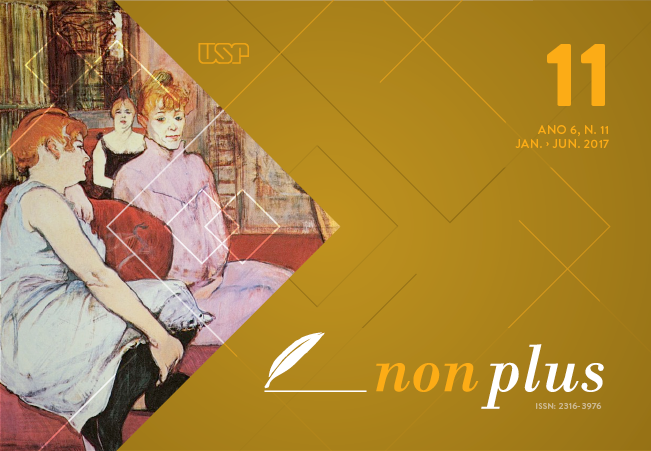Between vice and virtue: the double face of the courtesan in the work of Alexander Dumas son
DOI:
https://doi.org/10.11606/issn.2316-3976.v6i11p21-37Palavras-chave:
Courtesan, Prostitution, Vice, Love, Rehabilitation, Social virtueResumo
From the nineteenth century, some novelists will try to rid the courtesan from the traditional features. She is no longer represented in a negative light; that is, an unscrupulous character, without morals, without heart, unable to feel love. Among the authors who will try to rehabilitate the image of the courtesan, Alexander Dumas son takes a prominent place. Analyzing the Dumas son work, it follows the diagnosis of a dual perspective on courtesans’ social class. This social stratum is of ambiguity from the pen of Alexander Dumas son, in the sense that the courtesan endorses alternately, over the vicissitudes, the mantle of the sinner and the virtuous to suit the creative license of the novelist. Thus, if in La Dame aux Camelias, Dumas son shows that the rehabilitation of the courtesan is possible, in Le roman d’une femme, the novelist reveals that it is appropriate to defend courtesan and condemn this other form of prostitution practiced by married women of high society called "adulteresses."
Downloads
Referências
BÉDARD-VERREAULT, M. La virginité de la courtisane dans l’œuvre d’Alexandre Dumas fils : La Dame aux Camélias, 19 juillet 2010, [En ligne], URL : http://www.etudier.com/dissertations/LaDameAuxCam %C3 %A9lias.
BALZAC, H. La fille aux yeux d’or. Paris : Flammarion, 1988.
BARBEY D’AUREVILLY, J. Une vieille maîtresse. Paris : Gallimard, 1979.
CORBIN, A. Les filles de noce : Misère sexuelle et prostitution au dix-neuvième siècle. Paris : Flammarion, 1978.
DUMAS, A. (fils) Le roman d’une femme. Paris : Librairie Nouvelle, 1855.
___. L’Homme-Femme. Paris : Michel Lévy frères, 1872.
___. La Dame aux camélias. Paris : Charpentier, 1962.
___. « À propos de la Dame aux camélias ». In: DUMAS, Alexandre. La Dame aux camélias. Paris : GF Flammarion, p. 497-498, 1999.
___. Filles, lorettes, et courtisanes. Paris : Flammarion, 2000.
HUGO, V. Les misérables. Paris : Gallimard, 1985.
LECARME-TABONE, É. Manon, Marguerite, Sapho et les autres. Romantisme, n° 76, p. 23-41, 1992.
MAUPASSANT, G. de. Boule de Suif et autres histoires de guerre. Paris : Flammarion, 1990.
MOREL, L. Le féminisme d'Alexandre Dumas fils : (suite et fin). Le mouvement féministe : organe officiel des publications de l'Alliance nationale des sociétés féminines suisses. Zürich : Alliance nationale de sociétés féminines suisses, Volume 2, Cahier 21, p-66-68, 1914.
NEUSCHÄFER, H. « De la Dame aux camélias à la Traviata : l’évolution d’une image bourgeoise de la femme ». In : DUMAS FILS, Alexandre. La Dame aux camélias. Paris : GF Flammarion, p. 20-40, 1999.
PRÉVOST, l'A. Histoire du chevalier des Grieux et de Manon Lescaut. Paris : Le Livre de Poche, 2005.
ZOLA, É. Nana. Paris : Charpentier, 1881.
Downloads
Publicado
Edição
Seção
Licença
Ao enviar o material para publicação, o(s) autor(es) declara(m) automaticamente que o trabalho é de sua(s) autoria(s), assumindo total responsabilidade perante a lei nº 9.610, de 19 de fevereiro de 1998, no caso de plágio ou difamação, obrigando-se a responder pela originalidade do trabalho, inclusive por citações, transcrições, uso de nomes de pessoas e lugares, referências histórias e bibliográficas e tudo o mais que tiver sido incorporado ao seu texto, eximindo, desde já a equipe da Revista Non Plus, bem como os organismos editoriais a ela vinculados. O(s) autor(s) permanece(m) sendo o(s) detentor(es) dos direitos autorais de seu(s) texto(s), mas autoriza(m) a equipe da Revista Non Plusa revisar, editar e publicar o texto, podendo esta sugerir alterações sempre que necessário.
O autor(s) declara(m) que sobre o seu texto não recai ônus de qualquer espécie, assim como a inexistência de contratos editoriais vigentes que impeçam sua publicação na Revista Non Plus, responsabilizando-se por reivindicações futuras e eventuais perdas e danos. Os originais enviados devem ser inéditos e não devem ser submetidos à outra(s) revista(s) durante o processo de avaliação.
Em casos de coautoria com respectivos orientadores e outros, faz-se necessária uma declaração do coautor autorizando a publicação do texto.
Entende-se, portanto, com o ato de submissão de qualquer material à Revista Non Plus, a plena concordância com estes termos e com as Normas para elaboração e submissão de trabalhos. O não cumprimento desses itens ou o não enquadramento às normas editoriais resultará na recusa do material.


